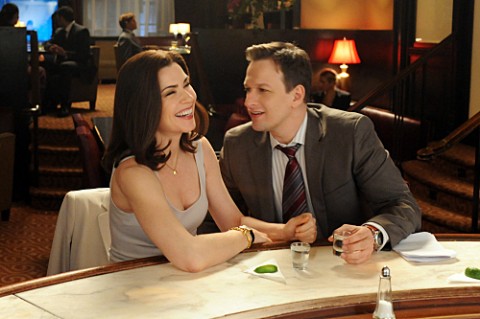We think of revival jewelry as a phenomenon that took place in the 19th century – and it is. But jewelers have been mining the past for inspiration since ancient civilization, and many still are. When you look at the history of antique jewelry, you see themes and techniques vanish and then reappear, over and over, altered to fit the times.
A couple museum exhibitions opened this year with fabulous examples of revival jewelry. I’m seeing a lot of revival-stye jewelry from younger designers as well lately, from Etruscan to archaeological, which tells me ancient jewelry has captured the imagination of a whole new generation.
Let’s start with Egyptian revival. This exotic style became wildly popular during the Deco period, after the 1922 discovery of King Tut’s tomb. But revivalist jewelers like Castellani were making Egyptian-style jewels 60 years before that, and Louis Comfort Tiffany was playing with the theme in his jewelry nearly a decade before the Tutankhamun excavation. Observe.
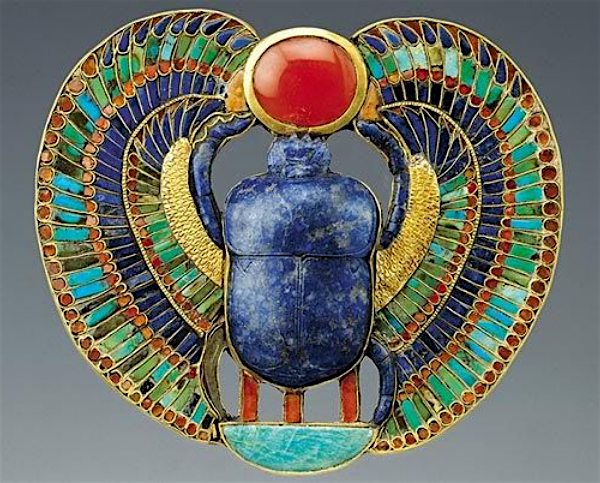
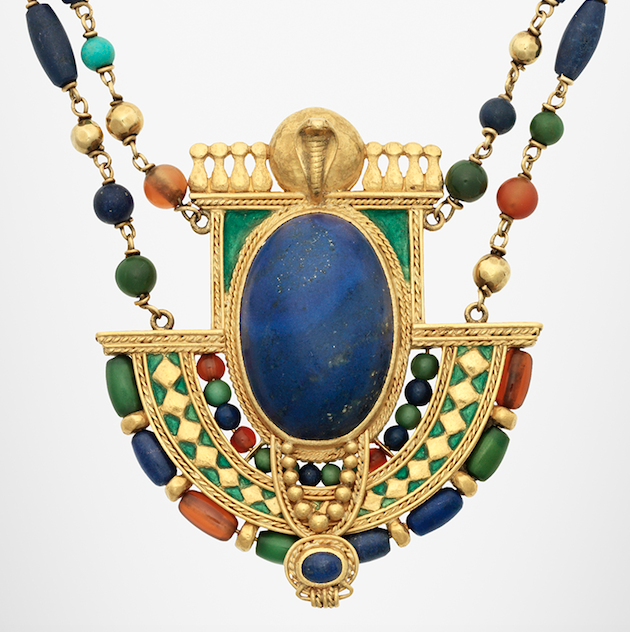
Revival is always happening in the jewelry world. That’s the central theme of Past is Present: Revival Jewelry at the MFA in Boston through August 2018. The 80 objects on display (including the Louis Comfort Tiffany beauty above) date from 2,400 B.C. to just a few years ago. In nearly every instance, the museum announced before the opening, “the design of the ornament highlights the tension between progress and the desire to engage with the past.”
That tension is set the moment you approach the museum’s jewelry gallery and two winged scarabs come into view. When you look closer, you discover one was made from faience between 740-660 B.C. The other is a stunning Cartier brooch created in 1924 with a carved smoky quartz scarab set in gold, platinum, faience, diamonds, emeralds, and enamel.
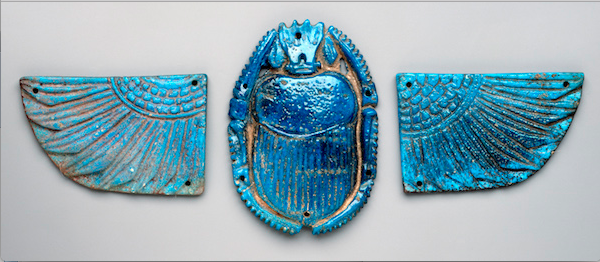
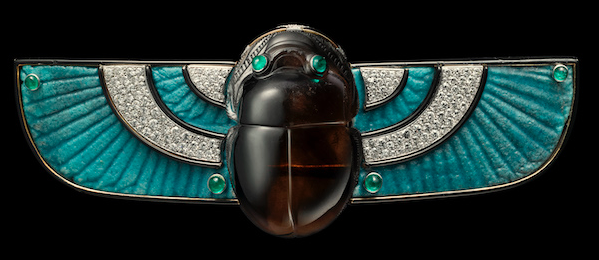
Wow, right? “That pairing really speaks to the exhibition, which is all about using fragments of the past as a source of inspiration,” says Emily Stoehrer, curator of jewelry at the MFA who organized Past is Present. It also represents the enduring fascination with Egypt, one of the first ancient civilizations to grab the popular imagination.
When I think of Egyptian-style jewels, the first thing that comes to mind – after the amazing originals – are Cartier pieces like the one above: exotic, colorful jewels from the Deco period. But Stoehrer points out the obsession with Egypt began long before that.
“There was a great interest in Egypt that started with Napoleon in the early 19th century and continued through the building of the Suez Canal in the 1860s,” Stoehrer says. “Then it really exploded after the discovery of King Tutankhamun’s tomb in the 1920s.”
“The best jewels of the Egyptomania period were Cartier’s,” she says. “So I was really excited that we were able to get a couple loans from the Cartier collection, including one of their amazing belt buckle brooches that uses ancient and modern pieces together.” She was equally excited by the fact that she had its perfect counterpart in her museum’s permanent collection.
That ancient scarab would have been sewn to the chest of a mummy. It’s the kind of artifact Louis Cartier was using for design inspiration two years after the discovery of King Tut’s tomb had set the global imagination on fire.
Here’s another Cartier winged scarab, a belt buckle from 1926 on display in another exhibition right now, The Jazz Age: American Style in the 1920s at the Cooper-Hewitt in NYC. This one looks a lot like the ancient original from the Boston museum – probably because Cartier made it from actual fragments of ancient Egyptian faience.
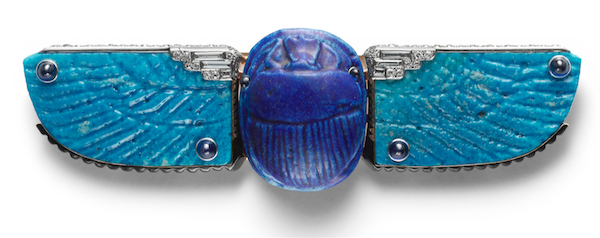
Cartier wasn’t the first to incorporate ancient fragments into his jewels. You’ll find them in another winged scarab that appears in Past is Present.
This one was designed around 1860 by Castellani, most famous of the 19th-century Revivalist jewelers. The Italian jeweler opted to embellish their scarab – an ancient faience carved with the baboon god – with micromosaic, an art form used since ancient time in the floors of Italy’s finest villas, miniaturized and perfected by Castellani. A matching necklace has 15 more scarabs, carved from sciatite and faience and set in the same micromosaic patterns and Egyptian palette.
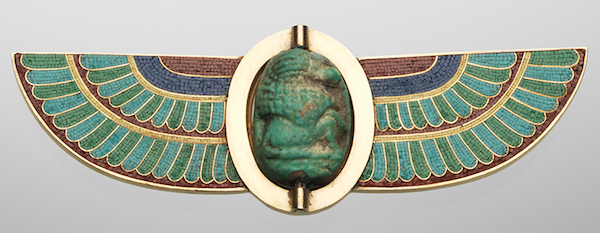
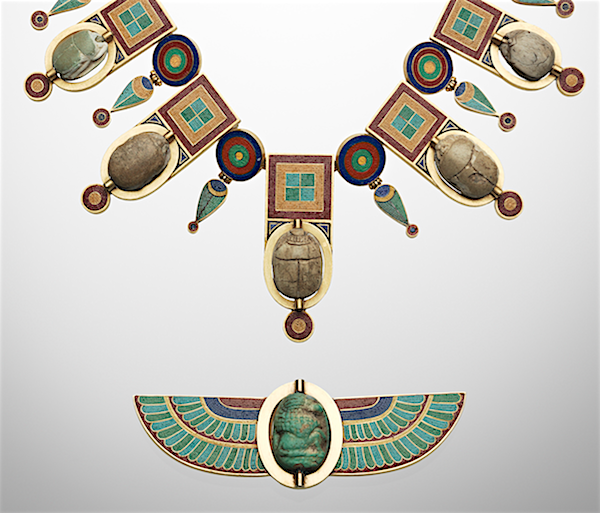
That set is featured in Celebrating Jewelry, the latest tome by jewelry historians Daniella Mascetti and David Bennett. The authors rave about the “brilliant and unexpected combination” of Egyptian scarab and Roman technique. One of several Revival masterpieces donated to the Boston Museum of Fine Arts around the turn of the century, soon after they were made, these Castellani jewels are a perfect example of the reinvention of historic themes with (then) contemporary technique.
I’ll close with probably the ultimate, definitely the most well-known, Egyptian-style jewel: the Deco diamond bracelet with colored stones. This one is not by Cartier – although they’re famous for them. This is by another notable jeweler of Jazz Age Paris, Lacloche Frères, who surprises us by using turquoise, black pearl and mother-of-pearl in place of the usual rubies, emeralds, and sapphires.
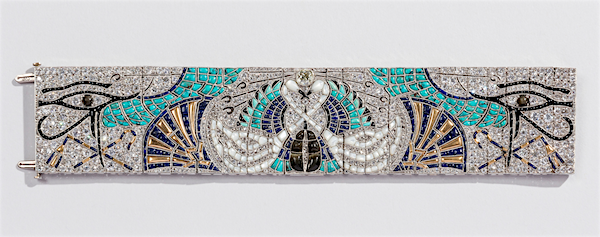
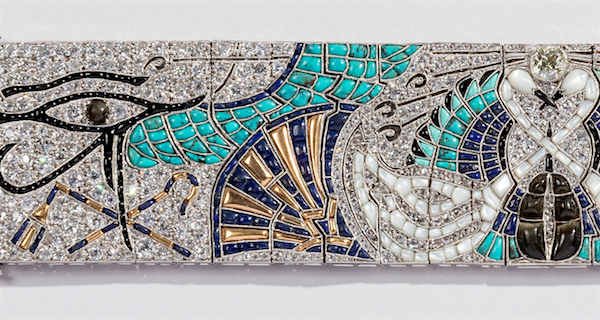
The Jazz Age closes August 27 at the Cooper-Hewitt in NYC, then reopens in September in Cleveland. It focuses on the modernism and exoticism that took hold of jewelry and the decorative arts in the 1920s and 1930s. You’ll find lots of rare and exotic Cartier, Van Cleef & Arpels, some amazing African-inspired Raymond Templier pieces – and some really amazing art, furniture and textiles. Don’t miss it!
But, if you do, there’s always the book.
No book for Past is Present, alas, but you have until August 2018 to get there. Well worth a trip to Boston. I will be revisiting both these exhibitions as we explore revival style. Stay tuned!


